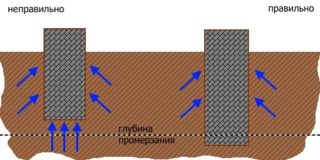The foundation is the basis of any building, which determines its durability and the possibility of operation. A solid foundation for a garage successfully resists weather conditions, the weight of the building, and soil vibrations.
- Examining the soil before building a foundation for a garage
- Carrying out foundation calculations
- Types of garage foundations
- Solid
- Welded
- Tape
- What is needed to build a foundation
- Reinforced concrete blocks
- Removable and non-removable formwork
- DIY foundation pouring instructions
- Nuances of laying the foundation
Examining the soil before building a foundation for a garage
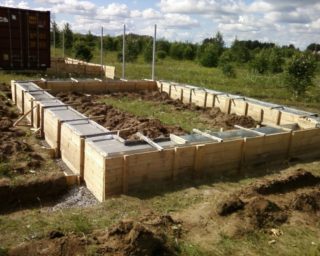
To build a foundation for a garage, it is important to study the soil: its type, moisture content, the depth of groundwater, the presence of communications laid below. The load on the soil and the depth of its freezing are also important.
The methodology for constructing a foundation on different types of soil differs. In any case, the base should not swell, deform, sag, twist.
- The ideal base is rocky ground. It is durable, resistant to moisture, not subject to erosion, breakage. Such a rock foundation does not shrink in winter, summer, and does not freeze. But these bases are not suitable for the arrangement of basements and basements.
- Homogeneous, low-compressible soils without erosion are the optimal solution for the construction site.
- A stable base is obtained on gravel soils that are not washed out by water and do not sink. Their freezing level is also insignificant - just over half a meter.
- Sands and sandy loams are also suitable for construction. Uniform density and good thickness contribute to the free penetration of water, which quickly goes deep into the depths, without expanding during frost. The freezing depth in central Russia does not exceed 1 meter.
- Soils with clay are problematic. Depending on its percentage, they are divided into subspecies: loam - 10-30%, sandy loam - up to 10%, clay - 35% and more. Loams and sandy loams let water through, freezing to a great depth - up to 2 m.When freezing and thawing, they swell and fall, pushing the foundation. Clay soil is characterized by sand content. There is a lot of it in red, less in blue.
- Peat bogs are not suitable for the construction of capital structures. Light or temporary structures in the form of sheds and country houses are usually installed on them. Peat soil contains acids that negatively affect materials.
It is desirable to conduct geological and engineering surveys to determine the strength of the soil, lump subsidence, swelling during freezing, resistance to lateral displacements.
If the soil is unprepared, it can be improved by adding sand, gravel-sand mixture. Sometimes a completely new layer is laid with tamping, vibration, or the existing one is reinforced with chemical additives.
On clay soils, it is necessary to accurately calculate the depth of the foundation, depending on the level of freezing.
Additional problems arise when watering soils above the freezing depth. It is impossible to establish a serious structure on such soil. For drainage, drainage ditches and gutters are used to drain excess liquid.
Carrying out foundation calculations
- The base must be on a solid, stable foundation. For hard rocky, coarse-grained, pebble soils, it is enough to install a shallow foundation - up to 0.8 m.
- Heavy clay soils, loams, and peat bogs require an increase in the depth of pouring up to 150 cm.On clayey - always below the freezing depth. Otherwise, the frozen water will deform the foundation, and when it thaws, it will release. Periodic deformation over time will lead to its destruction.
- For clay soils and peat bogs, it is advisable to install pile and solid concrete foundations. If necessary, make a tape - to deepen at least 20 cm below the freezing depth.
- Rocky and sandy soils are not so demanding on the massiveness of the base. The depth of the foundation should be no more than 80 cm.
The area located in the lowland is affected by melt water. If necessary, it is necessary to arrange a drainage ditch bypassing the foundation. The only way to confirm the depth of the groundwater is by drilling.
There must be at least 50 cm between the base of the foundation and the groundwater level.
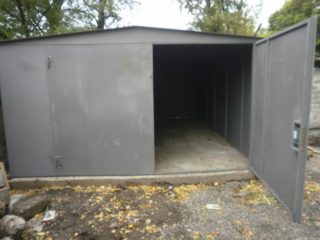
When calculating the foundation, the thickness and material of the walls of the building are always taken into account. The depth of the foundation tape and its thickness depend on this.
- Heavy walls made of bricks and concrete bear an increased load on the foundation. For the correct distribution of the load, the width of the base should exceed the thickness of the walls by 10-12 cm, taking into account the location of the formwork.
- Metal and easy-to-assemble structures are installed on a small shallow foundation.
The basement of the foundation should exceed the ground level by 20-30 cm. This rule is especially important for wooden and frame structures. The high plinth protects the garage from soil moisture.
Types of garage foundations
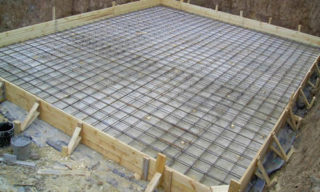
When constructing a base, many factors are taken into account. Starting from them, they choose the option of the foundation - tape, tiled, columnar. Its type depends on the mobility of the soil, water cut, density, freezing depth, the presence of a viewing hole, basement or cellar.
The garage is a small building. Often, the base for it is easily made on its own. But there are complex and costly projects if the structure is heavy, and the soils do not allow making a shallow-buried version.
Solid
Reinforced concrete pad is the simplest and most affordable solution that does not require complex calculations. Slab floating foundations will help on watered moving soils with high groundwater levels. Also useful on heavy clay soils. The method is expensive, but reliable, since the load is evenly distributed over the entire area of the slab. However, there are many difficulties, especially if the thickness exceeds 0.5 m: an increase in earthwork, the consumption of building materials.
The main disadvantage of a monolithic base is the impossibility of manufacturing a viewing pit, basement, cellar.
Welded
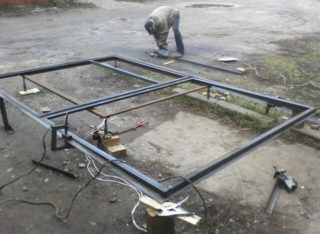
The foundation for a frame garage can be made entirely of metal materials. This is enough for light buildings. It is often constructed from pipes.
- Wells up to 1 m are drilled along the perimeter. The pipe is taken with a diameter of 100-150 mm. A clipped head is left above the ground, to which the grillage of the structure is attached.
- When laying inside the pit, sand or ASM with a thickness of about 10 cm is poured in, rammed.
- A sheet for the base with a thickness of 4-5 mm is welded to the bottom of the pipe, on top - a similar one for the grillage. All metal is processed with mastic.
- Soil is poured inside the pipe with compulsory ramming. If you want to increase the strength - concrete.
It is undesirable to use a welded foundation for a frame garage on peat soils, since increased acidity will lead to accelerated destruction of the structure.
Tape
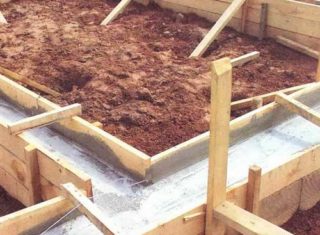
This compromise option is most often chosen. It is lighter than a solid slab. This type of foundation is appropriate for a heavy structure. Often used on loamy and clayey soils where swelling is common.Shallow-buried options are used for aerated concrete, frame, panel board, panel garages, which gives a considerable increase in budget savings.
Manufacturing technology is simple and does not require serious skills and costs. It is ideal for small structures, even with a two-story garage. Walls are erected on it from various materials from a light frame to a heavy brick one.
The depth of laying depends on the degree of freezing of the soil, bearing capacity, relief and weight of the structure being erected.
To increase reliability, it is installed on special support pits dug in below the freezing depth. They are located around the perimeter every 2 m.
Materials for a monolithic base - concrete, rubble concrete, brick, reinforced concrete.
What is needed to build a foundation
Reinforced concrete blocks
FBS blocks have high rigidity and stability. It is an excellent building material for building under any type of wall. The tape made of it is durable and solid. The downside is the need to use special equipment. FBS installation is appropriate when there is a lack of time.
Solid concrete will harden and gain strength for 21 days, and walls can be immediately mounted on FBS. This justifies the additional costs for special equipment.
Removable and non-removable formwork
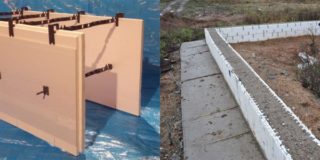
The foundation can be shallowly buried, which is sufficient on solid soils with a low weight of the structure, and buried under massive walls. For him, a removable formwork is made from boards or chipboard, which are attached with a bar. The bar is driven into the bottom of the trench, sheathed. For the manufacture of ventilation holes, pipe sections are poured inside. In order to avoid leakage of concrete, polyethylene is laid directly on the formwork. In addition to getting rid of drips, this trick will allow you to keep the boards clean and use them later for finishing work.
For permanent formwork, materials with excellent thermal insulation are used. After that, there is no need to insulate the basement and inspection pit. When building a detached garage, it is rarely used. Needed when building a garage adjacent to the house. Useful when using a basement for a workshop or utility room. The materials used are expanded polystyrene, reinforced concrete, metal.
DIY foundation pouring instructions
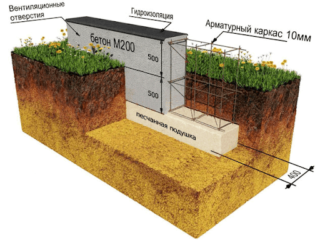
The construction technology for each of the foundations will be different. Strip foundations are the most common option.
- They mark the territory of the future structure.
- Formwork is being erected.
- The base is waterproofed.
- Lay down a sandy pillow. It should be at least 10 cm. During preparation, it is spilled with water and compacted.
- Concrete is poured.
It is difficult to mark the base alone, you need a partner. The technology for drawing the inner and outer boundaries is slightly different.
Basic markup rules:
- When carrying out excavation work to install the base, the integrity of the marking may be violated, which will distort the overall drawing of the surface. Make adjustments on time.
- A complex perimeter must be composed of simple shapes. They are then connected into a single circuit. Such actions speed up the markup.
Materials for marking: tape measure, pegs, construction cord, water level.
For removable formwork, boards or chipboard up to 2 cm thick, a bar of 40 * 40 mm are used.
- The bar is hammered through equal 40 cm segments.
- Sew on boards or sheets of chipboard.
- The top of the formwork is reinforced with spacers.
- The fill is carried out layer by layer or one-time.
- Prevent the appearance of air pockets by piercing the concrete with a stick in several places per 1 m.
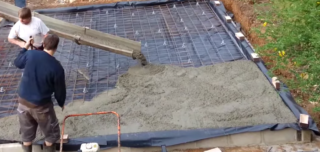
Pouring concrete:
- Knead in the proportion: 1 part of cement, 4 - gravel, 3 - sand.
- When pouring water, concrete of medium viscosity is obtained.
- The layers should be filled with an interval of no more than 6 hours - the base will turn out to be monolithic.
- The formwork is left for a week. After its removal, the concrete is kept for at least 3 days before the start of construction.
Prepare waterproofing. It is performed from the following materials:
- roofing material, hydro-barriers or tape seals;
- mastic;
- sealant;
- hydrophobic materials;
- paints and varnishes with polymer filling.
Waterproofing is available in vertical and horizontal versions. Vertical - in garages without a viewing hole. Horizontal - with a viewing hole.
Nuances of laying the foundation
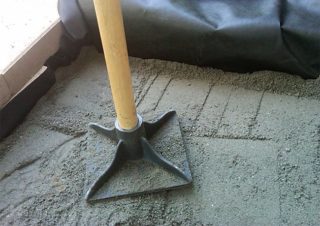
The main problem faced by the builders is the inspection pit. After commissioning, condensation and constant dampness form in it. This is due to the temperature difference inside the room and in the pit. To avoid dampness, rotting of the car, it is better to take the inspection hole outside the garage. If this is not possible, they do it separately from the parking place or close it hermetically.
Filling pitfalls:
- It is necessary to remove the entire fertile layer. Failure to comply with the rule leads to buckling of the soil.
- A sand and gravel pillow is a must. It mitigates the negative effects of soil swelling.
- If the sand cushion is not sufficiently compacted, shrinkage is possible.
- The proportions of the solution must be observed. In the dense, voids are formed. In liquid sand and gravel settle to the bottom.
- A small amount of reinforcement and a lack of tightness of the binding of the cells reduce the overall strength of the material.
- Thin fittings do not resist heaving. It is necessary to choose rods of 10-14 mm.
- If the reinforcement touches the sand bed, over time, the metal inside the concrete will begin to rust. The distance should be 50 mm.
- The close arrangement of the reinforcement to the formwork threatens to tear off pieces of concrete. The distance must be at least 50 mm.
The wrong choice of cement leads to fatal consequences. Each has certain characteristics. For the foundation for the garage, you need a brand from 200 to 500.

